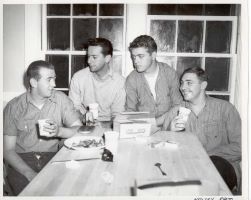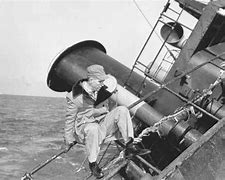Return to Division 13's Home Page.

THE HEROIC RESCUE OF THE PENDLETON CREW, 1952
On Feb. 18, 1952, four men risked their lives in a howling nor’easter off Cape Cod to save 32 mariners on the shipwrecked tanker Pendleton. They brought all but one to safety in a wooden motorboat designed to hold no more than 16 people.
The rescuers return to Chatham. Photo by Richard C. Kelsey, courtesy Cape Cod Community College. The rescuers return to Chatham. Photo by Richard C. Kelsey, courtesy Cape Cod Community College.
They were four Coast Guardsmen at the Chatham Lifeboat Station who volunteered to try to make what seemed to be an impossible rescue. They faced freezing temperatures and 60-foot waves in the hopes of reaching the Pendleton, an oil tanker that had snapped in two during the fierce storm. All received the Gold Lifesaving Medal, the Coast Guard’s highest honor, for “extreme and heroic daring.”
The Coast Guard called it the greatest rescue by a small boat in its history. The four men were called heroes. They shrugged it off and said they were just doing their job.
No SOS from the Pendleton
At 5 a.m. on Feb. 18, 1952, the Pendleton was headed south in blinding snow and violent seas 10 miles off the coast of Chatham, Mass. Suddenly the crewmen heard explosive cracking noises. The vessel lurched heavily and then broke in two.
Pendleton Sinking
The Pendleton’s bow section lost power and drifted south with the captain and seven crewmen aboard. The power remained on the stern section, and the chief engineer took charge and assigned duties to the 32 crewmen.
They didn’t manage to issue an SOS
At midmorning the Chatham Lifeboat Station got word that another tanker, the Fort Mercer, had also snapped in half. Cutters, an airplane and a lifesaving motorboat raced to rescue the vessel 20 miles off the coast.
Hours later, radar at the Coast Guard station showed the two broken pieces of the Pendleton.
Coxswain Bernard Webber was told to pick his crew and rescue the shipwrecked sailors. Three men volunteered for the suicidal mission: Coast Guardsmen Ervin Maske, Andrew Fitzgerald and Richard P. Livesey.

The Pendleton Crew
Rock of Ages
They launched the 36-foot boat named the CG-36500 into mountainous waves, blinding snow and zero visibility. To ward off fear, they sang Rock of Ages and Harbor Lights as they approached Chatham’s treacherous sand bar.
The Pendleton wreck lay just on the other side of the bar.The stern of the Pendleton. Note the ladder just beneath the smokestack. The stern of the Pendleton. Note the ladder just beneath the smokestack.
As they crossed the bar, a wave smashed into the CG-36500 and threw it high into the air. The boat landed on its side and righted quickly before another wave struck it. The breaker shattered the windshield, flattened Coxswain Webber and sent shards of glass into his face. It also destroyed the compass, their only navigational aid.
Capt. W. Russell Webster described what happened next in the Naval Institute Proceedings.
Creeping the boat forward, the searchlight soon revealed a pitch black mass of twisted metal, which heaved high in the air upon the massive waves and then settled back down in a “frothing mass of foam.” Each movement of the giant hulk produced a cacophony of eerie groans as the broken ship twisted and strained in the 60-foot seas. No lights were apparent as coxswain Webber maneuvered the small boat aft along the port side of the Pendleton’s stern section.
Rounding the stern, CG-36500’s searchlight illuminated the word PENDLETON and moments later, the larger vessel’s own deck lights became apparent. And, then a small figure above began frantically waving his arms! He soon disappeared. Coxswain Webber then saw a mass of people begin to line Pendleton’s starboard stern area, many shouting muffled instruction, which were unintelligible over the wind and crashing seas…. Without notice, a Jacob’s ladder was tossed over the side.

On Feb. 18, 1952, four men risked their lives in a howling nor’easter off Cape Cod to save 32 mariners on the shipwrecked tanker Pendleton. They brought all but one to safety in a wooden motorboat designed to hold no more than 16 people.
The rescuers return to Chatham. Photo by Richard C. Kelsey, courtesy Cape Cod Community College. The rescuers return to Chatham. Photo by Richard C. Kelsey, courtesy Cape Cod Community College.
They were four Coast Guardsmen at the Chatham Lifeboat Station who volunteered to try to make what seemed to be an impossible rescue. They faced freezing temperatures and 60-foot waves in the hopes of reaching the Pendleton, an oil tanker that had snapped in two during the fierce storm. All received the Gold Lifesaving Medal, the Coast Guard’s highest honor, for “extreme and heroic daring.”
The Coast Guard called it the greatest rescue by a small boat in its history. The four men were called heroes. They shrugged it off and said they were just doing their job.
No SOS from the Pendleton
At 5 a.m. on Feb. 18, 1952, the Pendleton was headed south in blinding snow and violent seas 10 miles off the coast of Chatham, Mass. Suddenly the crewmen heard explosive cracking noises. The vessel lurched heavily and then broke in two.
Pendleton Sinking
The Pendleton’s bow section lost power and drifted south with the captain and seven crewmen aboard. The power remained on the stern section, and the chief engineer took charge and assigned duties to the 32 crewmen.
They didn’t manage to issue an SOS
At midmorning the Chatham Lifeboat Station got word that another tanker, the Fort Mercer, had also snapped in half. Cutters, an airplane and a lifesaving motorboat raced to rescue the vessel 20 miles off the coast.
Hours later, radar at the Coast Guard station showed the two broken pieces of the Pendleton.
Coxswain Bernard Webber was told to pick his crew and rescue the shipwrecked sailors. Three men volunteered for the suicidal mission: Coast Guardsmen Ervin Maske, Andrew Fitzgerald and Richard P. Livesey.
Rock of Ages
They launched the 36-foot boat named the CG-36500 into mountainous waves, blinding snow and zero visibility. To ward off fear, they sang Rock of Ages and Harbor Lights as they approached Chatham’s treacherous sand bar.
The Pendleton wreck lay just on the other side of the bar.The stern of the Pendleton. Note the ladder just beneath the smokestack. The stern of the Pendleton. Note the ladder just beneath the smokestack.
As they crossed the bar, a wave smashed into the CG-36500 and threw it high into the air. The boat landed on its side and righted quickly before another wave struck it. The breaker shattered the windshield, flattened Coxswain Webber and sent shards of glass into his face. It also destroyed the compass, their only navigational aid.
Capt. W. Russell Webster described what happened next in the Naval Institute Proceedings.
Creeping the boat forward, the searchlight soon revealed a pitch black mass of twisted metal, which heaved high in the air upon the massive waves and then settled back down in a “frothing mass of foam.” Each movement of the giant hulk produced a cacophony of eerie groans as the broken ship twisted and strained in the 60-foot seas. No lights were apparent as coxswain Webber maneuvered the small boat aft along the port side of the Pendleton’s stern section.
Rounding the stern, CG-36500’s searchlight illuminated the word PENDLETON and moments later, the larger vessel’s own deck lights became apparent. And, then a small figure above began frantically waving his arms! He soon disappeared. Coxswain Webber then saw a mass of people begin to line Pendleton’s starboard stern area, many shouting muffled instruction, which were unintelligible over the wind and crashing seas…. Without notice, a Jacob’s ladder was tossed over the side.